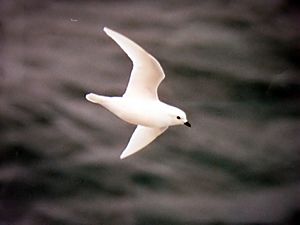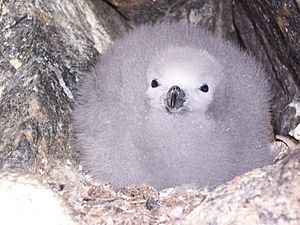Snow petrel facts for kids
Quick facts for kids Snow petrel |
|
|---|---|
 |
|
| Conservation status | |
| Scientific classification | |
| Genus: |
Pagodroma
|
| Species: |
nivea
|
| Subspecies | |
|
P. nivea nivea (G. Forster, 1777) |
|
 |
|
| range | |
The snow petrel (scientific name: Pagodroma nivea) is a special bird found in the icy lands of Antarctica. It's the only bird in its group, called Pagodroma. This amazing bird is one of only three types of birds ever seen at the Geographic South Pole. The other two are the Antarctic petrel and the south polar skua. Snow petrels build their nests further south than any other bird, deep inside Antarctica.
Contents
Discovering the Snow Petrel
The snow petrel was first described in 1777 by a German scientist named Georg Forster. He wrote about it in his book A Voyage Round the World after traveling with James Cook on his second trip around the Pacific Ocean. Forster saw the bird near ice and wrote:
We particularly observed a petrel, about the size of a pigeon, entirely white, with a black bill and blueish feet; it constantly appeared about the icy masses, and may be looked upon as a sure fore-runner of ice.
Forster first put the snow petrel in the group Procellaria. Later, in 1856, a French scientist named Charles Lucien Bonaparte created a new group just for the snow petrel, called Pagodroma.
What's in a Name?
The name Pagodroma comes from ancient Greek words. Pagos means "frost" or "sea-ice," and dromos means "racer" or "runner." So, it's like an "ice-runner." The word nivea comes from Latin and means "snow-white," which perfectly describes the bird. The name "petrel" comes from Peter the Apostle walking on water. This is because petrels often look like they are running on the water when they take off.
Snow Petrel Family Traits
The snow petrel belongs to the bird family Procellariidae and the larger group Procellariiformes. All birds in this group share some cool features:
- Nose Tubes: They have special tubes on their upper beak called naricorns.
- Unique Beaks: Their beaks are made of several horny plates.
- Stomach Oil: They can make a special oil in their stomach. They can spray this oil at predators like skuas to defend themselves. This oil is also a super energy-rich food for their chicks and for the adults during long flights.
- Salt Glands: They have a salt gland above their nose. This helps them get rid of extra salt from their bodies because they drink a lot of ocean water. They get rid of the salty water through their nostrils.
Snow Petrel Subspecies
Scientists recognize two main types, or subspecies, of snow petrels:
- P. n. nivea (Forster, G, 1777) — These birds breed on the Antarctic Peninsula, the South Georgia Islands, and other islands in the Scotia Arc.
- P. n. major (Schlegel, 1863) — These birds breed on the South Sandwich Islands and the Géologie Archipelago.

Appearance
The snow petrel is a small, completely white bird. It has dark, coal-black eyes, a small black beak, and bluish-gray feet. It usually measures about 30 to 40 centimeters (12 to 16 inches) long. Its wings can spread out to about 75 to 95 centimeters (30 to 37 inches) wide. When it flies, it moves in an unpredictable way, often changing direction quickly.
Behavior
Snow petrels mostly live in the very cold waters around Antarctica. You can often see groups of them sitting on icebergs.
Reproduction and Life Cycle
Snow petrels gather in large groups called colonies to breed. They build their nests on the Antarctic continent and on various Antarctic islands. Their nests are usually simple scrapes in the ground, lined with pebbles. They often choose deep rock cracks that offer protection from above. Some colonies are near the sea, but others are far inland, even more than 400 kilometers (250 miles) from the open ocean.
Birds start arriving at the colonies from mid-September to early November. They lay one white egg between late November and mid-December. The egg is kept warm for 41 to 49 days. After hatching, the chick is cared for by its parents for about 8 days. The young birds are ready to fly about 7 weeks later, from late February to mid-May. If heavy snow covers their nests, they might leave them. About half of the eggs don't survive, and 10-15% of chicks also don't make it.
Snow petrels are known to be very loyal partners. They stay with the same mate for their entire lives, which can be around 20 years!
What Snow Petrels Eat
Snow petrels mainly eat fish, but they also enjoy cephalopods (like squid), mollusks, and small shrimp-like creatures called krill. They also eat dead animals they find, such as seal placentas, dead seals, whale carcasses, and dead penguin chicks. In winter, they spread out across the pack ice, ice floes, and the open sea to find food. It's very rare to see them north of the main pack ice.
Conservation Status
The snow petrel lives across a huge area, about 35.9 million square kilometers (13.9 million square miles). Scientists estimate there are about 4 million adult snow petrels. Because they are so widespread and have a large population, the IUCN (International Union for Conservation of Nature) has listed this bird as least concern. This means they are not currently in danger of disappearing.
See also
 In Spanish: Petrel níveo para niños
In Spanish: Petrel níveo para niños




